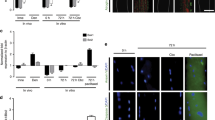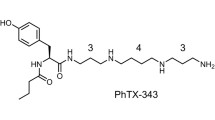Abstract
The rate of desensitization of nicotinic acetylcholine (ACh) receptor (nAChR), an important characteristic of nAChR function, was studied in myotubes of the mouse C2C12 cell line at different times after fusion, by measuring the decay of ACh-evoked currents (I ACh) under various patch-clamp configurations. We observed a progressive slowing of I ACh decay rate (half-decay time rose from about 0.5 s to over 5 s) in myotubes of increasing size (i.e. age) under all experimental conditions, except in outside-out patches, when I ACh decayed as fast as in the smallest myotubes. Single-channel conductance (about 35 pS) and open time (about 3.5 ms), measured in outside-out and cell-attached patches, were independent of myotube size. In Xenopus oocytes injected with poly(A+)RNA extracted from C2C12 myoblasts or mature myotubes, I ACh decay was about 50 times slower than in myotubes. Neither cAMP-dependent nor diacylglycerol-dependent protein kinases, actin nor microtubule polymerization state influenced I ACh decay. Our data indicate that the cellular environment, but not readily dialysable cytosolic factors, markedly influences the functional behaviour of nAChR.
Similar content being viewed by others
References
Bloch RJ (1986) Actin at receptor-rich domains of isolated acetylcholine receptor clusters. J Cell Biol 102:1447–1458
Camacho P, Liu Y, Mandel G, Brehm P (1993) The epsilon subunit confers fast channel gating on multiple classes of acetylcholine receptors. J Neurosci 13:605–613
Caratsch CG, Grassi F, Eusebi F (1992) Functional regulation of nicotinic acetylcholine receptor-channels in muscle. In: Narahashi T (ed) Ion channels, vol 3. Plenum, New York, pp 177–206
Changeux J-P, Galzi J-L, Devillers-Thiery A, Bertrand D (1992) The functional architecture of the acetylcholine nicotinic receptor explored by affinity labelling and site-directed mutagenesis. Q Rev Biophys 25:395–432
Cohen BN, Labarca C, Davidson N, Lester HA (1992) Mutations in M2 alter the selectivity of the mouse nicotinic acetylcholine receptor for organic and alkali metal cations. J Gen Physiol 100:373–400
Dilger JP, Liu Y (1992) Desensitization of acetylcholine receptors in BCH-1 cells. Pflügers Arch 420:479–485
Fallon JR, Hall ZW (1994) Building synapses: agrin and dystroglycan stick together. Trends Neurosci 17:469–473
Froehner SC (1991) The submembrane machinery for nicotinic acetylcholine receptor clustering. J Cell Biol 114:1–7
Froehner SC (1993) Regulation of ion channel distribution at synapses. Annu Rev Neurosci 16:347–368
Grassi F, Fucile S, Eusebi F (1994) Ca2+-signalling pathways activated by acetylcholine in mouse C2C12 myotubes. Pflügers Arch 428:340–345
Hamill OP, Marty A, Neher E, Sakmann B, Sigworth FJ (1981) Improved patch-clamp techniques for high-resolution current recording from cells and cell-free membrane patches. Pflügers Arch 391:85–100
Hoffman PW, Ravindran A, Huganir RL (1994) Role of phosphorylation in desensitization of acetylcholine receptors expressed in Xenopus oocytes. J Neurosci 14:4185–4195
Horn R, Marty A (1987) Muscarinic activation of ionic currents measured by a new whole-cell recording method. J Gen Physiol 92:145–158
Huganir R, Greengard P (1990) Regulation of transmitter desensitization by protein phosphorylation. Neuron 5:555–567
Inestrosa NC, Miller JB, Silberstein L, Ziskind-Conhaim L, Hall ZW (1983) Developmental regulation of 16S acetylcholinesterase and acetylcholine receptors in a mouse muscle cell line. Exp Cell Res 147:393–405
Karlin A (1993) Structure of nicotinic acetylcholine receptors. Curr Opin Neurobiol 3:299–309
Katz B, Miledi R (1977) Transmitter leakage from motor nerve terminals. Proc R Soc Lond [Biol] 196:59–72
Kusano K, Miledi R, Stinnakre J (1982) Cholinergic and catecholaminergic receptors in the Xenopus oocyte membrane. J Physiol (Lond) 328:143–170
Lindau M, Neher E (1988) Patch clamp techniques for time-resolved capacitance measurements in single cells. Pflügers Arch 411:137–146
Martinou J-C, Merlie JP (1991) Nerve-dependent modulation of acetylcholine e-subunit gene expression. J Neurosci 11:1291–1299
Methfessel C, Witzemann V, Takahashi T, Mishina, M, Numa S, Sakmann B (1986) Patch clamp measurements in Xenopus laevis oocytes: currents through endogenous channels and implanted acetylcholine receptor and sodium channels. Pflügers Arch 407:577–588
Miledi R (1980) Intracellular calcium and desensitization of acetylcholine receptors. Proc R Soc Lond Biol 209:447–452
Mileo AM, Palma E, Polenzani L, Limatola C, Grassi F, Eusebi F (1995) Protein kinase C modulates exogenous acetylcholine current in Xenopus oocytes. J Neurosci Res (in press)
Morales A, Sumikawa K (1992) Desensitization of junctional and extrajunctional nicotinic ACh receptors expressed in Xenopus oocytes. Mol Brain Res 16:323–329
Naranjo D, Brehm P (1993) Modal shifts in acetilcholine receptor channel gating confer subunit-dependent desensitization. Science 260:1811–1814
Neubig RR, Krodel EK, Boyd ND, Cohen JB (1979) Acetylcholine and local anesthetic binding to Torpedo nicotinic postsynaptic membranes after removal of nonreceptor peptides. Proc Natl Acad Sci USA 76:690–694
Rosenmund C, Westbrook GL (1993) Calcium-induced actin depolymerization reduces NMDA channel activity. Neuron 10:805–814
Ruknudin A, Song MJ, Sachs F (1991) The ultrastructure of patch clamped membranes: a study using high voltage electron microscopy. J Cell Biol 112:125–134
Sakmann B, Methfessel C, Mishina M, Takahashi T, Toshiyuki T, Kurasaki M, Fukuda K, Numa S (1985) Role of acetylcholine receptor subunits in gating of the channel. Nature 318:538–543
Salpeter MM, Loring RH (1985) Nicotinic acetylcholine receptors in vertebrate muscle: properties, distribution and neurol control. Prog Neurobiol 25:297–325
Sine SM, Taylor P (1980) The relationship between agonist occupation and the permeability response of the cholinergic receptor revealed by bound cobra α-toxin. J Biol Chem 21:10144–10156
Trussel LO, Zhang S, Raman IM (1993) Desensitization of AMPA receptors upon multiquantal neurotransmitter reelease. Neuron 10:1185–1196
Villarroel A, Herlitze S, Koenen M, Sakmann B (1991) Location of a threonine residue in the α-subunit M2 transmembrane segment that determines the ion flow through the acetylcholine receptor channel. Proc R Soc Lond Biol 243:69–74
Vyskocil F, Nikolski EE, Edwards C (1983) An analysis of the mechanisms controlling and underlying the non-quantal release of acetylcholine at the mouse neuromuscular junction. Neuroscience 9:429–435
Yaffe D, Saxel O (1977) Serial passaging and differentiation of myogenic cells isolated from dystrophic mouse muscle. Nature 270:725–727
Yamakura T, Mori H, Shimoji K, Mishina M (1993) Phosphorylation of the carboxyl-terminal domain of the ζ1 subunit is not responsible for potentiation by TPA of the NMDA receptor channel. Biochem. Biophys Res Comm 196:1537–1544
Author information
Authors and Affiliations
Rights and permissions
About this article
Cite this article
Grassi, F., Palma, E., Mileo, A.M. et al. The desensitization of the embryonic mouse muscle acetylcholine receptor depends on the cellular environment. Pflugers Arch. 430, 787–794 (1995). https://doi.org/10.1007/BF00386177
Received:
Revised:
Accepted:
Issue Date:
DOI: https://doi.org/10.1007/BF00386177




